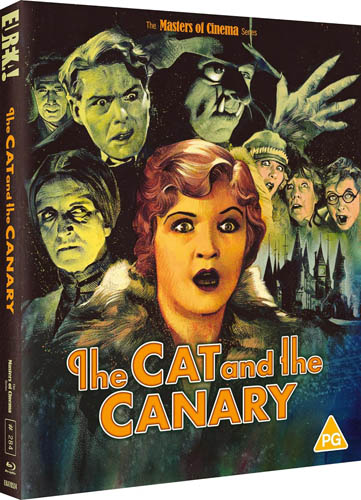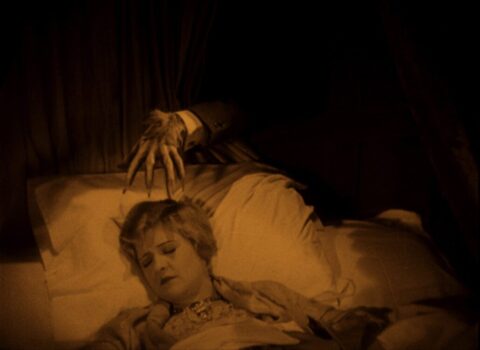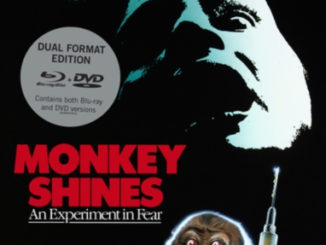(1927)
Directed by: Paul Leni
Written by: Alfred A. Cohn, John Willard, Robert F. Hill
Starring: Creighton Hale, Forrest Stanley, Laura La Plante, Tully Marshall
USA
AVAILABLE ON BLU-RAY: 22nd April, from EUREKA ENTERTAINMENT
RUNNING TIME: 88 mins
REVIEWED BY: Dr Lenera

In a decaying mansion overlooking the Hudson River, dying millionaire Cyrus West orders that his last will and testament remain locked in a safe and go unread until the 20th anniversary of his death. As the appointed time arrives, West’s lawyer, Roger Crosby, discovers a second will in the safe, which may only be opened if the terms of the first will aren’t fulfilled. As midnight approaches, West’s relatives descend upon the mansion. The will is read and it turns out that Annabelle West, the only heir with his name left, inherits, if she’s deemed sane. If she isn’t, the money and some diamonds go to someone else, whose name is in a sealed envelope. Then Crosby disappears before he can reveal the successors name and an escaped lunatic called the Cat has escaped from a nearby asylum….

Nearly a year and a half ago I reviewed the 1939 version of John Willard’s play The Cat And The Canary, and now I get to review the 1927 adaptation. The remake, or should I say the second remake – there was also a version which is now lost from 1930 and even a much later one in 1978 – is much shorter, tightening the pace, but only sometimes has a bit of the thick atmosphere which pervades this version, even though they share the same cinematographer. In fact even more of the play, which I assume this 1927 movie is fairly faithful too, was cut than it might at first seem because the comical character of Paul Jones, played by Creighton Hale, was expanded into a showcase for Bob Hope, who’s centre stage for much of the time and is constantly cracking wisecracks, yet, despite said wisecracks not always managing to be actually funny, fits rather well into the proceedings. This is partly because this first version is also self-aware – to the point where it has a weird doctor urn up who [no doubt deliberately] looks like Werner Krauss out of The Cabinet Of Dr Caligari – and has a sense of humour. Paul Leni managed to pull off a commercial comedy horror, following a very familiar template, yet was still able to include a fair bit of German Expressionist stylistics, where set design and lighting were employed psychologically, visually showing the tormented states of their characters, creating sometimes astonishing and influential worlds. And when I say “familiar template”, I mean it – we’d already had the likes of The Ghost Breaker, The Bat, The Monster and The Gorilla, cinematic versions of popular Broadway stage plays which were mysteries set in old dark houses with some laughs to offset the chills. The Cat And The Canary probably didn’t offer much that was new in terms of plot, characters and situations, but the trend was still hugely popular at the time, and Leni was able to turn it into probably the defining film of this little subgenre.
Hands brush away dust to reveal the title, followed by the credits, in a perfectly pitched introduction, which is followed by a quite extraordinary opening scene which must have truly stunned viewers at the time, many of whom asking, “how did they do that”? After text tells us about this mansion, followed by a shot [or rather painting] of said building, the place’ s towers dissolve into bottles on a table. As the writing informs the viewer that millionaire Cyrus West had been driven to madness by his relatives, with medicine not at all helping, we see a tiny Cyrus among the bottles which dwarf him, while two huge cats loom over the tableau. We see West go to sleep, and in the middle of the screen a tony white oblong materialises which gets bigger and eventually turns into the envelope which contains the “last will and testament of Cyrus Weet, to be opened after his death”, before disappearing, to be then replaced by another envelope with written on it, “this envelope is never to be opened if the terms of my will are carried out”; a clawed hand puts this back in a safe. Then we have the camera panning right along some blowing curtains and down a hallway full of things covered in sheets, to revel somebody walking down another hallway. Leni is saying to cinemagoers “this may be based on a play, but it ain’t a play, it’s a movie”. The person is housekeeper Mammy Pleasant, though one wonders why she still lives or even goes there seeing as West’s ghost is reputed to be walking down the corridors of the place. There’s a knock at the door, and it’s West’s lawyer, Roger Crosby, it now being the 2oth anniversary of West’s death. Crosby finds a second will in the safe, which may only be opened if the terms of the first will are not fulfilled, though Mammy blames this on West’s ghost, a notion that the astonished Crosby quickly rejects.
As midnight approaches, West’s relatives arrive at the mansion: nephews Harry Blythe and Charles “Charlie” Wilder, Paul Jones, his sister Susan Sillsby and her niece Cecily Young, and niece Annabelle West. Jones isn’t actually a relative, but he stopped his car so he didn’t run over a black cat and then his tire burst, though he tells people that he heard and literally dodged a bullet. West’s fortune is bequeathed to the most distant relative bearing the name “West”, which is of course Annabelle. The will, however, stipulates that to inherit the fortune, she must be judged sane. If she is, the fortune is passed to the person named in the second will. The fortune includes the West diamonds which her uncle hid years ago. Annabelle realises that she is now like her uncle, “in a cage surrounded by cats.” Not to mention that a painting of West has just fallen off the wall. Says Mammy, “this is an evil omen, something terrible will happen here tonight”. Crosby suspects someone in the family might try to harm Annabelle and decides to inform her of her successor, but before he speaks the person’s name, a hairy hand with long nails emerges from a secret passage in a bookshelf and pulls him in, terrifying Annabelle in a nice bit of terror which must have scared manty viewers at the time, not least because we sew the bookshelf open and close a few seconds before it happens, building anticipation. When she explains what happened to Crosby, the family immediately concludes that she’s insane, though surely she’ s not as insane as The Cat, an escaped lunatic who could be either in the house or on the grounds. As a guard tells them, “he’s a maniac who thinks he’s a cat, and tears his victims like they were canaries!”. Alone in her assigned room, Annabelle examines a note slipped to her which reveals the location of the family jewels, fashioned into an elaborate necklace, but she has to be careful. Who can she trust?

Despite the atmosphere that’s been set, the accent is on comedy for some time, some of it verging on send-up without ever really becoming such a thing, despite the frequent presence of the baleful Mammy. “It must have been lonely here the last few years”, she’s asked. “I don’t need the living ones” she replies. She’s an intriguing, uncanny presence and played with surprising subtlety for the period by Tully Marshall, who’s able to achieve so much with just a look, and a look that isn’t exaggerated. In some later moments, we wonder about her and possible connections to other characters. Susan and Cecily’s driver won’t drive into the mansion. “Why”? asks Susan. “Ghost” is the answer, the word printed big and flickery on the screen. “Gosh what a spooky house” says Cecily as her words float upwards. Yes, we even have fun with the intertitles – later on there’s a zoom into a mouth as a woman cries “help”!, though words are still kept to a minimum. Of course much of the comedy revolves around Jones, who’s a coward and wears Harold Lloyd glasses yet both our heroine and Susan are still drawn to him. Creighton Hale in the part is mildly amusing, perhaps most so when he realises that he’s standing where a corpse hasn’t long been and a book flies off the shelf that’s behind him and hits him on the head, but no more than that, though a bit where he’s hiding under a bed and lustfully looking at Cecily’s legs and feet as she changes for bed is fun because it probably wouldn’t have been allowed a few years later. This whole sequence, which climaxes with Jones being mistaken for some kind of menace by Cecily, was totally eliminated from the 1039 version. I suppose it does slow the pace; in fact throughout the whole film scenes play longer than was probably normal for the period, but we’re engrossed, despite the simplicity of the characters, especially Isabelle who barely even has a character, while her being only properly proactive for one section would no doubt risk the ire of some critics today. Nonetheless veteran silent movie actress Laura La Plante is still able to make her likeable.
The scene of the will reading, the first part of it featuring the mechanics of a clock supposed imposed over the people and even West ranting about his relatives as we reach midnight, is highly suspenseful as well as crammed with odd touches, from extreme closeups to a face distorted in a glass, as if Leni set out to make a scene of people talking at a table as interesting as possible. The horror moments, which include an iconic bit of the shadow of a hand appearing over a woman’s body which was repeated in 1939, are well executed, dight down to some rather freaky if improbable monster makeup [nothing like a cat though], and provide a good contrast to this nicely balanced film which gets more serious as it progresses but never loses its sense of fun and never really lose its footing, even if Jones’s sudden transformation into action hero is hard to believe, while the faster cranking of the film – common to silent films – makes two fight scenes at the end look a little silly, though then again this practise was often retained for sound pictures for some time. Of course characters are often making silly choices which put them in danger, but then again this is still a familiar aspect of the horror genre. As to the actual mystery, part of it isn’t very surprising, but part of it [probably] is [as long as you haven’t seen any other versions of course]. And Leni, along with Lang, constantly keep things looking interesting with unusual lighting, odd staging and a very mobile camera, while Charles D. Hall’s Gothic sets keep the European vibe going as well as looking forward to his work on the likes of Dracula and Frankenstein. One memorable shot has a character filmed through chairs before sitting down and being framed by one, another adopts the point of view of a painting, while shadows really linger. Some shots were virtually copied in, appropriately, The Old Dark House.
Just so incredibly likeable from beginning to end, The Cat And The Canary remains tremendous fun, a silent movie that can easily be enjoyed by modern viewers; hell, I think even older kids, if they’re with their parents, would enjoy it, partly because it really doesn’t date as much a film made nearly one hundred years old ought to. Personally I love it when films are made with an artistic vision yet which are still intended to be for a mass audience and make money.
SPECIAL FEATURES
Limited edition O-Card slipcase featuring new artwork by Graham Humphreys [2000 copies]
1080p HD presentation on Blu-ray from a 4K digital restoration of the original negatives supplied by MoMA
While a few shots have a lot of flickers, indicating print damage too severe to repair, they are few and far between. In general this film looks superb considering its age, with a large amount of detail showing through. The majority of it is tinted sepia, but we also get a bit of blue, green and normal black and white.
DTS-HD MA 5.1 score by Robert Israel; compiled, synchronised and edited by Gillian B. Anderson, based on music cue sheets compiled and issued for the original 1927 release
Even if this wasn’t based on the original cue sheets, one still probably couldn’t have wished for a nicer musical accompaniment, with its mixing of period jauntiness and in-your-face melodrama – along with a few quotes from classical music, something which was very common at the time. Another excellent effort from Israel.
Brand new audio commentary by author Stephen Jones and author / critic Kim Newman
I always look forward to hearing both talk track pairings that are on this disc. Newman tells us that Mummy Pleasant, who isn’t always called that, was Black in the play but not in the film versions nor the novel adaptation written by Willard himself, that the majority of the many films the cast members were in are sadly lost, and that audiences were so used to getting a rational explanation for things that Dracula must have been a shock [“oh my god, he actually is a vampire”!], while Jones says that no less than three performers in the film died from blood poisoning which Newman wonders was a euphemism for something else, that Hale is in Sunset Boulevard billed as himself [if you know that film well, you might guess when he appears], and that Leni would often bang a gong to cue his performers! A typically fine track, loaded with enthusiasm and information.
Brand new audio commentary by Kevin Lyons and Jonathan Rigby
Earlier on today I was asking myself who I preferred; Jones and Newman, or Lyons and Rigby. The latter do more lists of credits, which is often my audio commentary bugbear though they do keep them brief, but then again they also read out bits of reviews of the time which is great. Rigby makes the important point that The Cat And The Canary was essentially the blueprint for the Unversal horror film as we know it, points out that hands are a frequent visual theme, and tells us more detail about the play, while Lyons reads out Leni’s letter [which we also see] to Lang for helping him achieve what he wanted, points out how Hall’s sets were so influential on the horror genre. and – perhaps most interestingly….. that we’ve been seeing the B camera cut of this film for many years because of only bad elements for the A cut surviving – up to now [silent films were often shot with two cameras side by side with the more central version kept for the American market and the one slightly off for export release].
Mysteries Mean Dark Corners – brand new video essay by David Cairns & Fiona Watson [29 mins]
I always look forward to these video essays, and this one is extremely educational about other films in this cycle, the origins of this particular story, and is even able to show some clips from the lost The Cat Creeps by having unearthed a comical short about horror movies from the period which referred to it. Watson chimes in about two thirds of the way through to talk about the actual film, us learning that Leni’s excessive eating may have contributed to his death. One comes away having a much better picture of context, and maybe even wanting to see, for example, one of the versions of The Bat!
Pamela Hutchinson on “The Cat and the Canary” – brand new interview with writer and film critic Pamela Hutchinson [13 mins]
Hutchinson is unknown to me, but she speaks with great enthusiasm about this film so I’d like to see again on one of these things. She begins by describing it as “exquisitely divine fun” and sees it as a sort of high point of silent film art even though it wouldn’t be watched during film courses, before covering Leni and the cast, in perhaps slightly more detail than we’ve heard in the commentary tracks.
.Phuong Le on “The Cat and the Canary” – brand new interview with film critic Phuong Le [9 mins]
It’s often interesting to compare these pieces by different critics about films. Le begins by telling us that in the play the heroine has “romantic interaction with other male characters” though it wasn’t in the film – well, not this version – the 1939 one had a little bit. She then talks in detail about the filming style [Leni said the actor’s faces obscured the lighting], and tells us that the housekeeper was originally West Indian, not Black as others on this disc have said!
A Very Eccentric Man & Yeah, a Cat! – extracts from John Willard’s original play [5 mins & 2 mins]
These verbal re-enactments of the play make one wish we could have heard the entire thing. I’d have happily listened to it on one of the frequent rainy evenings we’re getting at the moment!
Lucky Strike – Paul Leni gives a full-throated endorsement to the product that got him through filming “The Cat and the Canary” [1 min]
One has to chuckle at a film director advertising a “delightful cigarette” which caused him “no throat irritations whatsoever” [1 mins]
A collector’s booklet featuring new writing on the film by Richard Combs, Craig Ian Mann, and Imogen Sara Smith
This 1927 horror comedy is still absolutely delightful. Eureka have given deservedly fine treatment indeed. Highly Recommended!







Be the first to comment